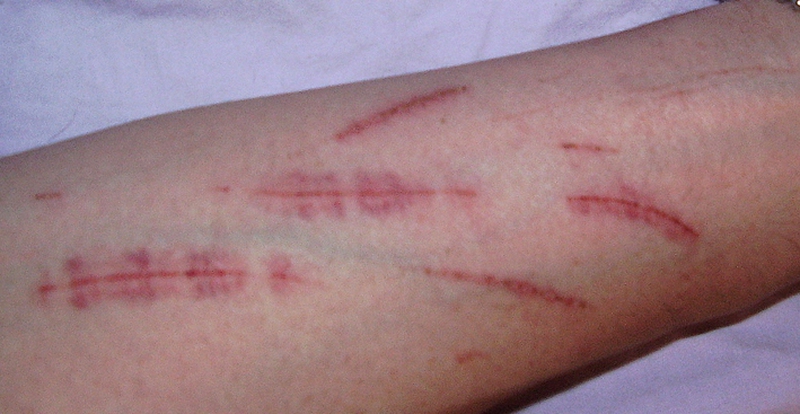“I can feel the hurt. There's something good about it. Mostly it makes me stop remembering.” ― Albert Borris, Crash Into Me
Self-Harm (SH), also called deliberate self-harm (DSH), is the intentional and direct injuring of body tissue by oneself without clear suicidal intentions. As most forms of human behavior, it’s a way the subject chooses to deal with overpowering levels of emotional anguish, to express it and get some relief from it. This behavior is not generally a mean to kill oneself, not intentionally anyways – although there are cases where the result has been fatal - but rather a sadistic-masochist self-punishment method. People engaging in this sort of procedures are generally in need of help, and their self-harm can also be seen as a way to seek help and attention on their condition.

10 Common Types of Self-Harm
Cutting Oneself
We have chosen to list this method of self-harm as number one because we believe it to be the one most people would think of first hand. This, however, is not true, as only about 30% of self-harming youngsters have been reported to cut themselves as a way of harming their bodies. It’s also a far more common method among females.
Using Objects
The second self-harm method includes punching or kicking certain objects, walls or materials, or either dropping stuff on oneself from a distance in order to cause bleeding or bruising oneself. About 40% of self-harming people have been reported to use this method.
Scratching/Pinching
This has proven to be quite an extended way of self-harm that it is reported in more than half of self-harming people, making of it the most common type of self harm on our list. It is the use of fingernails or certain objects to pick the skin or scratch it to the point of leaving marks or causing bleeding, generally with no serious consequences.
Carving
This way, albeit being quite unusual among self-harming people, has caught the attention of many by its peculiarity. It works by inscribing symbols, words or images in the skin, generally with the use of certain utensils, therefore involving some sort of ritualistic aspect to the act of damaging the body of oneself.
Ripping the Skin off
This is another bizarre and uncommon method, used by less than 15% of all reported self-harming people. It is basically the tearing-off of the skin tissue, generally using some sort of sharp object. It’s particularly dangerous as pealed-off skin will cause infections quickly.
Sex
Maybe regarded as a taboo method when it comes to talking about types of self-harm, an excessive or inexistent sex-drive and abusive sexual behaviors have also been considered as self-punishment methods by many, which often leads to promiscuity and infidelity, further causes even serious psychological damage.
Self-Burn
This is another unusual way for people to self harm themselves, and it is estimated that this self harm method is in less than 15% of all cases. It involves the burning of the skin, generally by using a lighter.
Impeding Healing
This method is also combined with one of the others in our list by refusing to heal oneself after having committed self-harm. It’s been reported in around 13% of all research subjects.
Hair-Pulling
More common amongst females, as you can imagine, this is another way people choose to harm themselves, often resulting in severe damage by extreme pulling of the hair.
Law-Breaking
We have left this one for last because it is still debatable whether to consider it as one of self harm methods or not, despite its recklessness and very serious consequences. Yet it is still considerable in the list.
IMPORTANT NOTE
Self-harm is quite a serious issue that should not be undermined or not taken care off. Anyone who believes himself to be in that situation to a certain extent (because we may all, at the end of the day, consider ourselves to be self-harming) where the condition is becoming ostensibly serious, should immediately seek professional assistance.
There are several professionals that can offer you their help on this issue. On one hand, you may need to heal your wounds and go to a doctor for this. On the other, if you believe you have an underlying condition to your self-harming behaviors, such as anxiety or depression, you may want to go see your GP, who may also be able to cure your inner wounds. They will ask you questions about your feelings and day-to-day attitude and behavior in order to properly establishing what is causing you to damage your body. Once you get to know the initial problem, you will be in better conditions to tackle the issue.
Your GP may proof very helpful when it comes to detect certain patterns in your behavior, particularly if we are talking about alimentary disorders. Knowing your enemy is a good starting point to combating it. After an initial assessment, you may be sent to your local mental health service, where psychologist will verify the underlying problems and be able to teach your skills and attitudes that will make you more confident and positive in order to fight your condition.



View All Comments /Add Comment